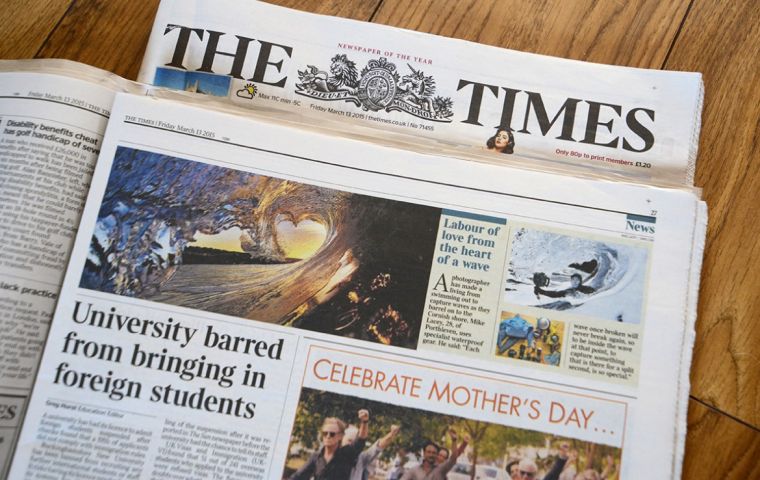MercoPress. South Atlantic News Agency
The Times and Sunday Times want to share resources, to build a sustainable future for Times' journalism
 UK's Department for Digital, Culture, Media and Sport decision is necessary as legal undertakings were made to keep them separate when Murdoch bought them
UK's Department for Digital, Culture, Media and Sport decision is necessary as legal undertakings were made to keep them separate when Murdoch bought them  John Witherow, editor of the Times, said: “The persistent cost pressures facing our industry mean that we need to manage our newsrooms as carefully as possible”
John Witherow, editor of the Times, said: “The persistent cost pressures facing our industry mean that we need to manage our newsrooms as carefully as possible” Rupert Murdoch newspapers The Times and the Sunday Times are asking the government for permission to share resources, including journalists, between the two titles. The application to the Department for Digital, Culture, Media and Sport (DCMS) is necessary as legal undertakings were made to keep them separate when he bought them in 1981.
The papers employ 505 between them. The DCMS is seeking public views on whether the changes are warranted.
John Witherow, editor of the Times, said: “The persistent cost pressures facing our industry mean that we need to manage our newsrooms as carefully as possible. We need to stay competitive in an increasingly difficult market so that we can continue to build a sustainable future for Times' journalism.”
News UK, the part of Murdoch's News Corp that owns the two papers, said the change would allow more flexibility to share resources across the titles, while continuing to commit to them remaining as separate newspapers with separate editors.
“This would enable the papers to contend with the continual disruption that has faced the media industry in the digital age,” News UK said. In the application, the papers cite a number of factors affecting the industry, including the fall in circulation as readers shift online.
It says the most “obvious way to achieve further cost savings without affecting the quality of journalism is to remove unnecessary duplication in costs inherent in running entirely separate Monday to Saturday and Sunday newspapers”.
It says that “virtually all” other major UK national appears have integrated their editions.
Martin Ivens, editor of the Sunday Times, said: “The Sunday Times remains the biggest selling broadsheet in Britain and to protect our distinctive voice we need the freedom to work more closely to avoid duplication and invest more in the agenda-setting journalism we are famous for.”
News UK, which also publishes the Sun, said that it amounted to a “small change” to the legal undertakings.
A spokesperson for the National Union of Journalists said: “We are concerned about the News UK request to change the existing legal undertakings and the potential impact shared content will have on journalists and journalism.
”Cuts are likely to follow if the company are allowed to proceed. We will be seeking further clarity about the details of the proposals announced today.“
The decision to agree to any changes to the legal undertakings rest with the Culture Secretary, Jeremy Wright.
Documents published by the DCMS, which invite comments on the matter by 5pm on 11 February, show that News UK first raised the topic in October and made a formal application last week.
The department also published a letter from the six independent national directors who oversee the editorial independence of the two papers. In it, the directors say they back the application in light of the ”powerful forces that affected the media industry since the advent of digital technology”.
The papers put up a pay-wall for their websites in 2010 and as of October the Times had an average daily paid print circulation of about 421,000, and paid digital subscribers of approximately 231,000. The Sunday Times had an average paid print circulation of about 723,000 and paid digital subscribers of approximately 254,000.




Top Comments
Disclaimer & comment rulesCommenting for this story is now closed.
If you have a Facebook account, become a fan and comment on our Facebook Page!